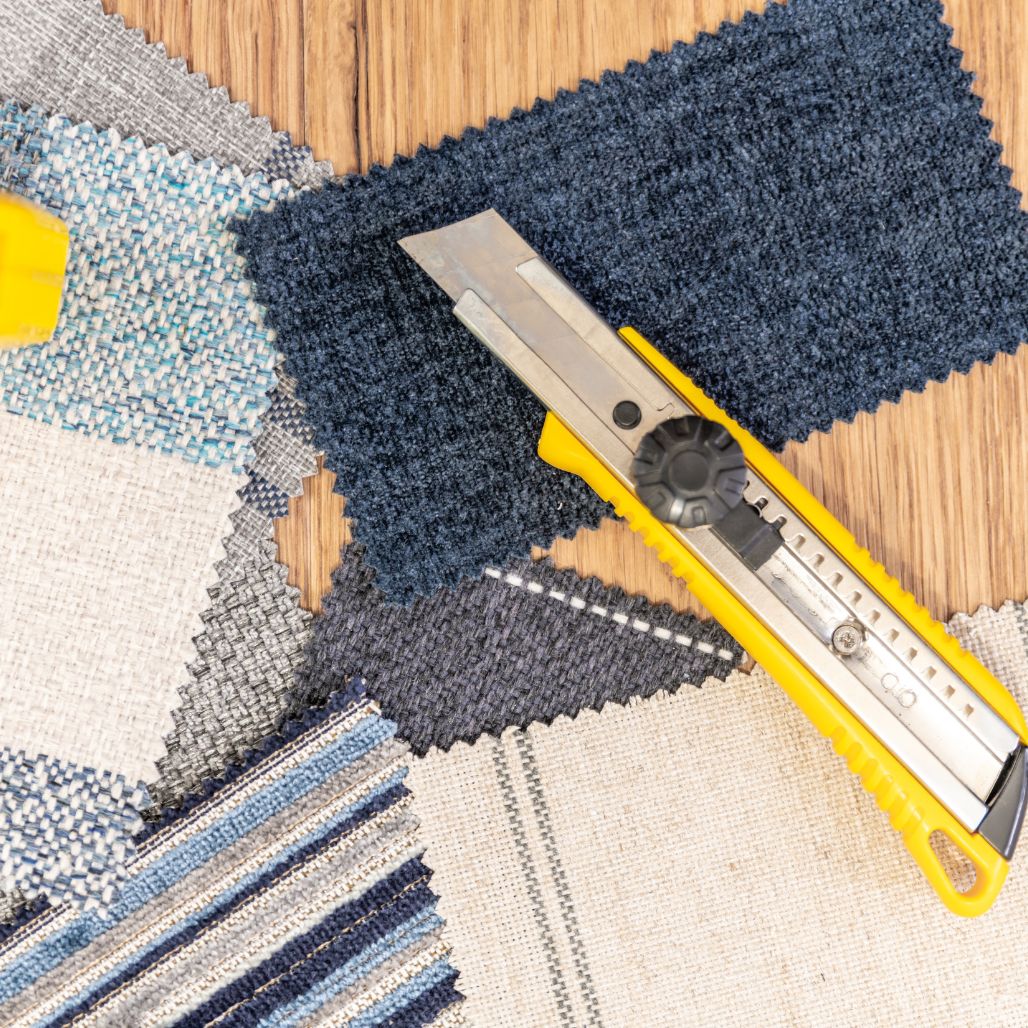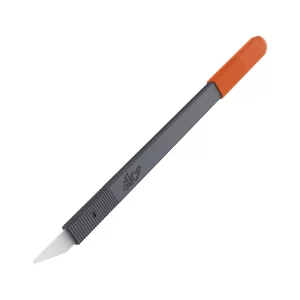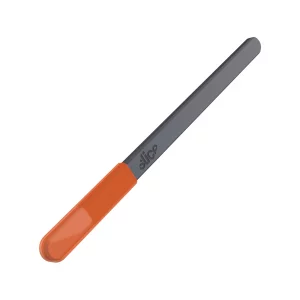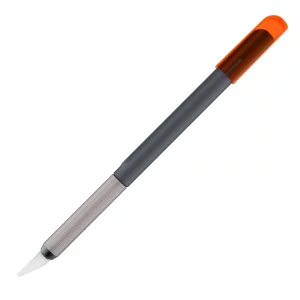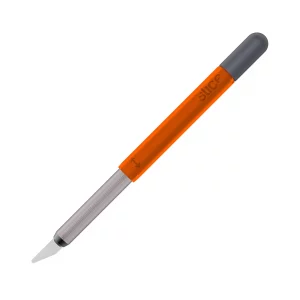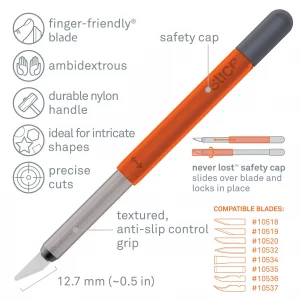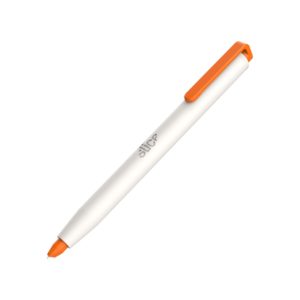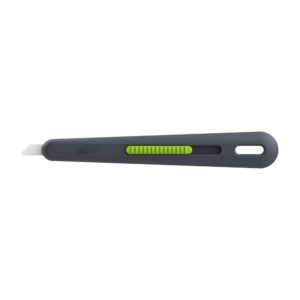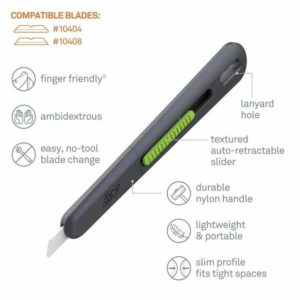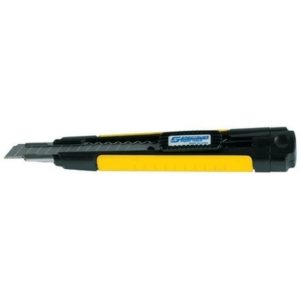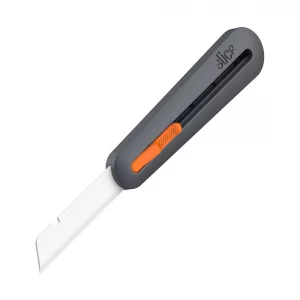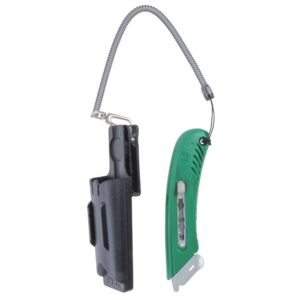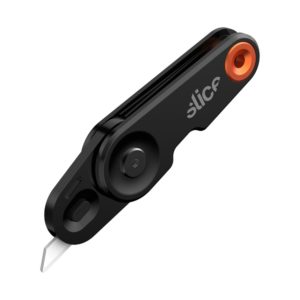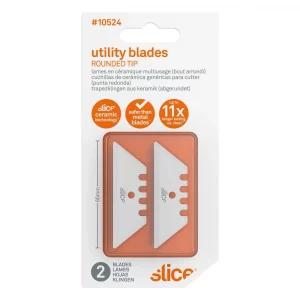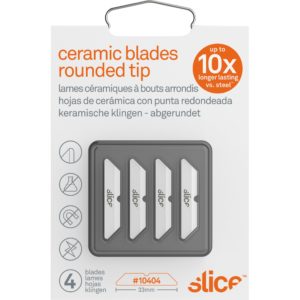Craft and hobby knives are widely used by artists, hobbyists, Etsy and Pinterest enthusiasts, and household hackers. Here, we examine the best craft and hobby knives on the market to make your next project a breeze.
The best hobby knife should be safe and effective. Ultimately, the decision is yours, so we recommend a few options depending on your use case and experience with safety cutters. Ceramic blades are safer than steel blades, making them useful for households.
What is a craft and hobby knife?
Remember back to your kindergarten class’s safety scissors? Well, now that you’re grown up, you need a highly effective tool. A hobby and craft knife is a bladed tool used to cut materials. And thanks to modern technology from companies like Slice, you’re highly effective craft and hobby knife won’t miss you under regular use.
Here’s a list of the most popular craft and hobby knives:
- Slice 10589 Craft Knife with Safety Cap
- Slice 10458 Craft Knife
- Slice 10568 Ceramic Scalpel
- Slice 10580 Precision Knife
- Slice 10417 Retractable Precision Cutter
- Slice 00200 Ceramic Blade Mini Safety Cutter
- Slice 10475 Ceramic Blade Slim Pen Cutter
- Pacific Handy Cutter SK-233 Snap-Off Stainless Steel Blade Cutter
- Slice 10416 Precision Cutter, Manually Retracted
Craft cutters depend on your task. Ceramic blades may be more useful as a comprehensive tool because the blade can cut more materials. But the size of the blade is also essential; the longer the edge, the deeper it can cut. Felt, cardboard, and paper may require different blade thicknesses and lengths to be most effective.
Do you need a tool that will last years? Ensure you buy from a trusted brand and that you can get the replacement blades quickly. We recommend Slice because their edges are finger-friendly®, meaning you can touch them safely, but obviously, don’t try to cut yourself because they are still incredibly sharp blades.
Ceramic blades are far less likely to cut you than steel blades. We strongly recommend ceramic blade cutters for children, seniors, and dexterity-limited hobbyists.
The 9 Best Craft and Hobby Knives
The Best Craft Cutter for Scrapbooking, Arts, and Crafts
Slice ceramic blade cutters are ideal for scrapbooking and arts and crafts. We recommend a mini or precision cutter, depending on your needs. Scissors and snap-off blade cutters are excellent at getting crisp, straight edges but may not work for intricate designs.
For finer details, we recommend the Slice 00116 Precision Cutter. Intricate shapes and curved lines are much easier when dealing with manageable blade sizes.
Take a look at the video below to see these tools in action!
The Best Craft and Hobby Knife – A Buying Guide
A precision knife excels when you need an exact cut across various cutting materials: paper, cardstock, vinyl, corrugated plastic, cardboard, kevlar, and heavy-duty materials. The suitable precision cutter yields a clean line, more so than scissors or other tools.
Plus, the right tool will reduce instances of injury by providing the essential features you need to get the job done. If you’re using utility knives already and want to know what key features you should look for when buying your first precision knife, keep reading!
What key features do the best precision cutters have?
Versatility
It’s not enough to just be used now and then. When you’re shelling out your hard-earned money, you don’t want it to go to waste. The best cutter is a multipurpose tool that can produce clean lines across various cutting surfaces.
The best cutter shouldn’t be phased by corrugated plastic or occasionally opening a box.
Ergonomic Design
Any tool you use needs to be comfortable for you. If at work for long hours, it helps to have a cutter you feel satisfied with. The knives we tested feature ambidextrous designs packed with additional safety features.
The best cutter should fit your hand well, giving you a firm grip that allows you to prevent your hands from slipping. The wrong knife size for your hand can you hand strain and fatigue.
Safety
It’s no use finding the perfect cutter if it hurts you. We recommend Slice cutters because the ceramic blade reduces laceration injuries. It’s no surprise that Slice’s finger-friendly precision cutters make up eight out of nine of the best knives on our list.
Some cutters come in multiple varieties, allowing you to choose how you want the blade to retract. Many cutters have two options, manual or automatic retraction, allowing you to determine what style works best for you.
Weight
If you’re working on a DIY project for long hours or working overtime in the lab, the weight of your knife may become a source of frustration. On the one hand, you want a knife with a decent weight, so you are not forced to strain when cutting. However, you want a knife that is manageable and easy to maneuver. We sought cutters that struck a good balance between being overly rugged and flimsy.
What material is best for precision knives?
We recommend ceramic blades because they blade is stronger than steel and more finger-friendly. A single laceration injury can cost upwards of $41,783 according to OSHA. By using a ceramic knife, you reduce the risk of injury, and your project benefits from having the best tool for the job.
While stainless steel blades do provide a consistent cutting-edge and reliable performance, the safety benefits of ceramic outweigh any downsides. Most of our feedback indicated that workers prefer ceramic knives because they don’t require blade changes as frequently. You can go months or years without changing the blade.
What did we look for in the best craft and hobby knife?
How does the blade retract?
Utility knives can either be auto-retractable or manually retracted, and the same goes for precision cutters. Some knives and scalpels have an exposed blade, so there is no need for a retractable mechanism. Generally, a true craft knife does not retract, whereas a more heavy-duty cutter will retract.
Does the knife include a safety cap?
Some precision knives include a safety cap, such as the Slice 10589 Craft Knife. Safety Caps are critical because they prevent the blade from dulling and protect your fingers.
How long will it last?
Buy it for life. We aim to find you the precision or craft and hobby knife you need. If it’s taken care of, all the knives on our list should have a long lifespan if taken care of. All the knives on our list have replaceable blades, meaning you save money from disposable alternatives. Plus, it reduces waste.
Is it easy to replace the blade?
All the knives on our list have replaceable blades. It’s essential to get a tool that doesn’t require another tool to change the blade. All the knives we feature have no-tool blade changes.
Conclusion – The Best Precision Cutter, Craft and Hobby Knife
If you want the best of everything, we recommend a Slice 10589 Craft Knife. For basic coupon cutting and maximum convenience, try the Slice 00200 mini safety cutter. More advanced projects that require a steel blade will benefit from the Pacific Handy Cutter snap-off blade cutter.
Innovative Features in Today’s Safety Cutters
Explore the many benefits of purchasing utility knives in bulk—from significant cost savings and enhanced workflow to environmental sustainability. This guide covers everything from the types of knives, essential buying tips, top brands, and effective usage strategies to safety practices and maintenance advice, helping you make the most informed decision at SafetyCutters.net.
The Ultimate Guide to Buying Bulk Utility Knives
Explore the many benefits of purchasing utility knives in bulk—from significant cost savings and enhanced workflow to environmental sustainability. This guide covers everything from the types of knives, essential buying tips, top brands, and effective usage strategies to safety practices and maintenance advice, helping you make the most informed decision at SafetyCutters.net.
Unleashing the Precision: Exploring the Benefits of Ceramic Scalpels
Introducing Slice Ambidextrous Ceramic ScissorsAs a professional in any industry, having the right tools can make all the difference. When it comes to cutting and
Discover Convenience and Safety: Introducing Slice Ambidextrous Ceramic Scissors
When it comes to warehouse operations, safety should always be a top priority. The use of safety cutters is an effective way to enhance warehouse safety.
Carpet Knife vs Utility Knife: Unraveling the Key Differences
Carpet knives, defined by their sharp, pointed blades ideal for soft flooring materials, contrast with the broader versatility of utility knives, which can address a myriad of cutting tasks.
Why Box-Cutter Gloves Are a Must-Have for Workplace Safety?
This article explores the importance of box cutter gloves in maintaining a safe work environment and providing reliable cut-safe protection.

